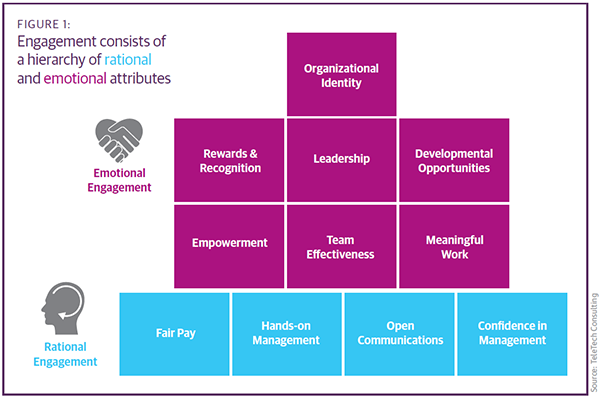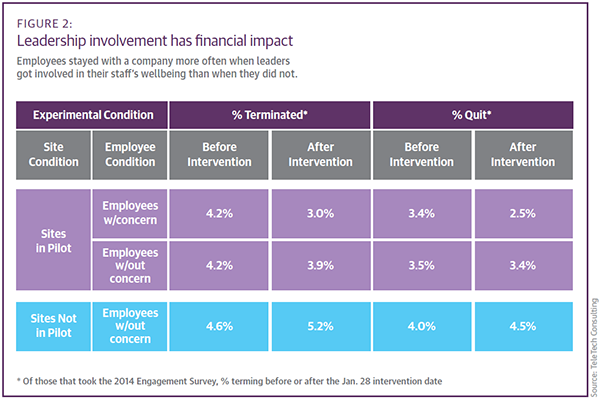With a strong U.S. economy and job market, employee engagement should move up to the top of the executive priority list. If employees are engaged, they will be less tempted to move elsewhere, even as jobs become more widely available. But what should executives do to give employee engagement the attention it warrants?
According to Gallup, there is a direct correlation between engaged employees and business results. Highly engaged business units result in 21 percent greater profitability, a 41 percent reduction in absenteeism, and a 17 percent increase in productivity. Engaged employees also translate into better customer experiences—highly engaged business units achieve a 10 percent increase in customer ratings and a 20 percent increase in sales.
Employee engagement is not a new topic, and many books have been written on the subject. In our research and work with clients, we have identified a number of rational and emotional factors that create a hierarchy of employee needs (see Figure 1). Foundational rational elements such as compensation, communication, and confidence in management must be present first to build stronger emotional engagement around team and individual attributes, such as team effectiveness, meaningful work, and developmental opportunities. All of these build to a positive organizational identity that matches what an employee values.
Employee engagement is often the responsibility of human resources or employee communications. At many companies, it’s not an executive priority. Our research shows that this is the wrong thinking.
We conducted a two-year study of global organizations and worked with our partner, Zenger Folkman, to analyze data from 65,000 leaders worldwide regarding leadership’s influence on employees, customers, and business. What we found was a powerful correlation between what leaders do, the experience their employees have, and how strongly their customers advocate for them.
In addition, TeleTech further studied the impact of the positive action leaders took following engagement surveys. We found that when senior leaders intervened to resolve issues brought up in employee surveys, terminations dropped by 29 percent, and voluntary attrition dropped by 26 percent. For those who did not intervene, terminations actually increased by 13 percent, and voluntary attrition rose by 12.5 percent (see Figure 2).
In addition, we looked at NPS and saw that there is a positive correlation of employee engagement improvement relative to customer NPS scores, which appeared six months following employee engagement uplift.

Leadership activities to start and stop
Beyond delivering a good product at a good price or good working conditions at a decent salary, both employees and customers fundamentally want businesses to do two things:
• Remove friction: Make it easy to do business with you and for you.
• Create positive emotions and experiences: Make it enjoyable, insightful, and even delightful.
So it’s the job of the leader to eliminate friction, create great experiences for employees, and empower them to do the same for customers.
To successfully engage employees, leaders need to demonstrate they have the skills and are prepared to invest in the right people, create the desire and want to implement changes, and invest in the technology and processes to enable execution of the desired state. This is a change journey to create a culture that’s customer-obsessed, with an ongoing passion for celebrating wins, learning from mistakes, and continuously improving.
While this seems like common sense, it’s far from common practice. Across the 65,000 global leaders assessed, four key attributes stood out in terms of a customer experience X Factor (what we refer to as the ‘CX Factor’). They provide insights into what leaders need to stop doing to create an exceptional employee experience:
1. STOP tolerating (or smothering) risk taking, and start celebrating it
Become the business that puts you out of business. Our research found that high-performing leaders have an amazing ability to develop and communicate strong strategic perspective that significantly impacts employee engagement, which in turn drives the customer experience. What separates CX leaders from their peers is their ability to understand underlying customer needs, analyze the market, the competitive landscape, and emerging trends so they stay one step ahead of customer expectations. They shape cultures where risk is not just tolerated but celebrated, and they create teams and departments whose sole task is to be the business that puts them out of business.

2. STOP developing KPIs purely about the company
Measure metrics that actually motivate. Top leaders inspire their entire team around goals that go beyond traditional (boring) commercial metrics, connecting everything back to an individual and collective purpose that creates intrinsic motivation toward a better future. They never set goals without a clear path for how they can be achieved, and these goals and ambitions center on the customer rather than the company, provoking a true paradigm shift toward customer obsession across the organization.
3. STOP relying on your authority as influence
Cancel command and control leadership styles. High-performing leaders have a clear ability to influence without using their authority, which enables them to inspire and motivate their people to high performance, build customer advocacy, and drive business results. Employees, like customers, have more options and choice than ever and they are increasingly refusing to accept that things can’t be done differently and better.
4. STOP acting in isolation
Shatter silos from the top down. The old saying that a champion team beats a team of champions couldn’t be truer when playing the complex and competitive game of customer experience. Silos kill collaboration and amplify friction. In the research, a key differentiator of exceptional leaders was their ability to promote collaboration and teamwork across the business, knowing that collaboration is the key to innovation.
The research indicates that those with these four “CX Factors” have a significant advantage when it comes to creating an exceptional employee experience and boosting engagement, which is a critical factor in shaping a compelling customer experience that creates significant competitive advantage and commercial results.






